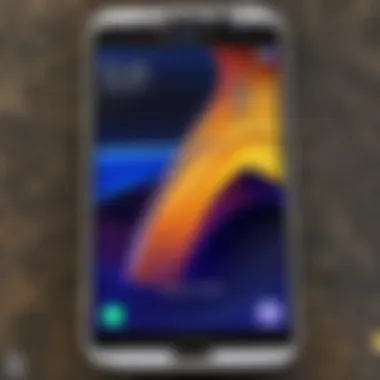An In-Depth Analysis of Samsung Galaxy 2017 Models


Intro
In 2017, Samsung launched a trio of smartphones that would go on to define the market for years to come. Among these devices, the Samsung Galaxy S8, S8+, and Note8 achieved not just commercial success but also transformed user expectations. This article strives to unpack their intricate specifications, highlight their groundbreaking features, and analyze their overarching impact on the smartphone industry.
Champion Spotlights
Samsung Galaxy S8 Showcase
The Samsung Galaxy S8, released in March 2017, was positioned as a flagship device. It introduced a radical design with bezels significantly reduced. The 5.8 inches Super AMOLED display captures attention with vibrant colors and deep blacks. Alongside the aesthetic improvements, the device offered an 835 Snapdragon processor and options for either 4GB or 6GB of RAM, depending on storage configurations.
Its camera system relied on a 12 MP dual pixel rear camera. The smartphone's lens technology coupled with software enhancements like Bixby Vision provided an unparalleled photography experience.
Samsung Galaxy S8+ Spotlight
The S8+ carved its niche by appealing to consumers seeking larger displays. With a 6.2 inches panel, it effectively enriched the multimedia viewing experience. Specifications matched those of its smaller sibling, featuring the same Snapdragon 835 processor and camera capabilities. However, it did feature a larger battery, constraints which allowed longer usage periods. Notably, Bixby became a support function across these devices, marking a push towards AI integration.
Note8: Power in One Hand
The Samsung Galaxy Note8 expanded on the S series features by introducing an S Pen that facilitated unique multitasking and productivity enhancements. With its 6.3 inches screen and identical camera functionality as the S8 devices, it presented an alternative for those blending work and leisure.
A refined dual camera setup enabled improved depth of field in photography. Features like Live Focus showed Samsung's focus on capitalizing on user creativity. Together, these elements resulted in a smartphone designed for versatility.
Samsung's strategic focus in its 2017 releases underscored not just innovation but an understanding of evolving user demands.
Key Features Examination
The Samsung Galaxy S8, S8+, and Note8 shared common core attributes while exhibiting distinct nuances. Consider the water-resistance rating of IP68, ensuring resiliency in various conditions, a necessary feat for modern smartphones. Additionally, all models supported wireless charging standards, aligning with growing ecosystem preferences.
Design Philosophy
In this lineup, Samsung leaned heavily into aesthetic and functional design philosophies. Each device's glass back and metal frame evoke a sense of finesse, marrying form with utility. The return of expandable storage catered to users preferring flexibility in data management. Additionally, the decision to eliminate the physical home button spoke volumes about evolutionary trends toward gesture-based navigation.
Performance Metrics
Rooted in the Snapdragon 835 processor, these devices powered through demanding tasks without any hiccups. Whether it was gaming or intensive multitasking, the RAM options accommodated varied user needs. Performance outcomes especially shone in benchmarks, where these devices outpaced competitors, establishing Samsung as a leader.
User Feedback and Market Impact
User feedback positioned the Galaxy line favorably. Many praised the stark screen, intuitive interface, and camera capabilities. Critics, however, sometimes pointed to Bixby's limitations compared to established rivals. Yet, the enduring influence of these models fundamentally shifted market expectations. Users started to perceive more value in high performance coupled with elegant designed hardware.
As we analyze further, understanding how these devices reshaped consumer behavior and market dynamics will unravel a narrative of not just innovation, but new market benchmarks.
Foreword to Samsung Galaxy
The Samsung Galaxy 2017 models constitute a pivotal chapter in the evolution of smartphones. In an era where technology is fast-paced, the devices released that year possess not only outstanding specifications but also enduring relevance. These models set standards that ambitious manufacturers continue to strive for. This introduction will dive deep into what made 2017 significant for the Samsung Galaxy series, focusing on the innovations introduced and their implications in the marketplace.
Overview of Samsung Galaxy Series
The Samsung Galaxy series has been a driving force in the mobile industry since its inception. By the time we reached 2017, Galaxy phones were not only about basic calls and texting but transformed into powerful computing devices. Features like large, edge-to-edge displays and high-resolution cameras began to dominate the user experience. In 2017, Samsung released significant models like the Galaxy S8, S8+, and Note8. These smartphones offered improved processors, higher RAM capacities, and sophisticated sensors that astound users and set benchmarks for rivals.
Importance of Features
Key specifications of 2017 models included water resistance ratings, expandable storage, and superior battery life.
- Galaxy S8 and S8+: The introduction of the Infinity Display marked a shift in design philosophy, enhancing the aesthetics and usability.
- Note8: The S Pen enhanced multitasking capabilities, appealing particularly to professional users.
Significance of the Year
2017 stands out for several reasons in the context of smartphone development. The launch of these flagship devices came at a time when competitors were rapidly innovating.
Shift in Consumer Preferences
Growth in mobile gaming and demanding applications necessitated powerful smartphones. Gamers and tech enthusiasts expected more than just basic functionalities; hence brands had to adapt and up their game.
Technological Advances


Technologically, 2017 served as a launchpad. Features such as dual cameras on the Note8 shifted expectations around photography on smartphones, captivating a market that craved better media output.
Blockquote: > The Galaxy series of 2017 would forever imprint a legacy on consumer standards, influencing competitor strategies and setting tangible goals for future innovations.
In summary, the Samsung Galaxy models of 2017 encapsulate a moment in the evolution of phones from communications tools to full-fledged mobile computers. As the article progresses, we will explore each model’s unique capabilities, investigative benchmarks, and broader market implications.
Samsung Galaxy S8 and S8+ Features
The Samsung Galaxy S8 and S8+ models introduced several significant features that marked their prominence in the smartphone market of 2017. Their attribute list includes design improvements, enhanced camera technology, and a powerful performance baseline. Understanding these features within the Galaxy series context helps unpack their market impact and consumer reception. Both models set high standards for aesthetics and functionality, creating a pathway for future devices in the industry.
Design and Display Innovations
The design of the S8 and S8+ is a key point of discussion. Samsung focused on creating a visually striking device with minimal bezels, resulting in a "Infinity Display" that stretches from edge to edge. This not only enhances the immersive experience when using the device but also establishes a sophisticated look that appealed to consumers.
These models featured AMOLED technology that offered vibrant colors and deep contrast. Such attributes rolling were popular among users who valued graphic throughput and battery efficiency. The curved edges encouraged ergonomic holding, furnishing an appealing method to interact with flashy applications and games this was useful for gamers enjoying League of Legends.
Such forward-thinking design laid the groundwork for mobile device aesthetics that the competition began to adopt thereafter. Without a doubt, the display technology became a benchmark for high-end smartphones.
Camera Technology
The evolution of camera technology in the Samsung Galaxy S8 and S8+ offers noteworthy advancements in terms of both rear and front-facing cameras. These models boasted exceptional imaging capabilities that catered to professionals and casual users alike.
Rear Camera Specifications
Regarding the rear camera specifications, the S8 and S8+ featured a 12MP dual-pixel sensor, which enabled excellent low-light photography. This camera stood out due to its impressive aperture, which was set at f/1.7, allowing maximum light capture even in dim environments. Consumers with photography interests appreciated the pro-like settings available through the camera interface. This versatility made it a popular choice
The inclusion of optical image stabilization further enhanced shooting capabilities, ensuring that users could take sharp images without excessive blur.
Front Camera Features
When it came to the front camera features, a significant selling point was the 8MP sensor combined with an aperture of f/1.7 as well. This enabled high-quality selfies advantageous for social media sharing. Dual functions include autofocus targeting and wide-angle captures, indeed ensuring clarity whether you click selfies or set up group shots. Gamers seeking to live-stream their gameplay had an edge with enhanced video resolutions when utilizing the S8 and S8+.
Together, the camera features established Samsung's devices as prominent choices for users who prioritize photography and videography.
Performance Metrics
Performance is always paramount when analyzing smartphone models. Here, the S8 and S8+ showcased powerful specs intended for demanding applications and gaming.
Processor Comparisons
The Samsung Galaxy S8 was powered by the Exynos 8895 or Qualcomm Snapdragon 835, depending on the region. These processors delivered remarkable performance with efficient power usage, which is essential for gamers and heavy-duty users alike. Effective multitasking yielded a pleasant experience even when switching between intensive applications.
The processing capabilities further benefited gaming environments that required quick actions such as in League of Legends to maintain smooth graphics. Gamers needed only their devices to engage efficiently, showcasing the quality Samsung was breeding into the market.
Battery Life Expectations
In addition to top-notch processors, the battery life expectations were promising. The S8 featured a 3,000mAh battery, while the S8+ had 3,500mAh. These could last through extended gaming sessions without constant interaction with the charger. Coupled with energy-efficient processors, users enjoyed longer usage times sustainably. This performance characteristic made both models attractive in today’s digitally engaged environment, ensuring that users could participate continuously in their activities, including power-intensive gaming.
Delve into the features presented by the S8 and S8+ models; they reshaped expectations for smartphones following 2017.
In summary, the Samsung Galaxy S8 and S8+ encompassed pivotal features that contributed to their lasting significance in the market. Design innovations steeped in performance upgrades set benchmarks that future competitors would struggle to reach.
Samsung Galaxy Note8 Overview
The Samsung Galaxy Note8 emerged as a significant model in the 2017 line-up, specifically designed for power users and those who prioritize productivity in a smartphone. Recognized for its advanced features, the Note8 serves as both a communication tool and a portable workstation for many individuals. This section dissects the various attributes that make the Note8 stand out, focusing on design, S Pen capabilities, and multitasking features.
Design Elements
The design of the Samsung Galaxy Note8 is striking and polished, retaining the premium quality that the Galaxy series is known for. Its 6.3-inch display is not just large, but also boasts QHD+ resolution with Infinity Display technology, offering vibrant colors and deep contrasts. The device incorporates Gorilla Glass 5 on both front and back, contributing to its overall durability against drops and scratches.
Functionality is key in this model. The dual rear cameras, positioned vertically, accentuate the phone's modern aesthetics while also supporting high-quality photography. The additional aspect of water and dust resistance (IP68 rating) enhances its usability in various environments, allowing users to push the boundaries of where they can take their device.
S Pen Enhancements
The S Pen has always set the Note series apart, and the Note8 includes thoughtful enhancements. It provides precise control over navigation and enhances creativity through features such as:


- Live Message: This allows users to create animated GIFs or send handwritten notes.
- Screen Off Memo: Capturing quick thoughts on the fly without the need to unlock the phone saves time for busy individuals.
These enhancements reflect the demand for more seamless functionality, especially for gamers and creative types. The S Pen is pressure-sensitive, providing an authentic writing experience, which users appreciate in note-taking or graphic creation, catering specifically to the demographics that prioritize their device for both leisure and work-related activities.
Multitasking Capabilities
Multitasking is at the core of the Galaxy Note8's appeal. The device seamlessly supports split-screen functionality, which permits users to run two applications simultaneously. For gamers set on strategizing while keeping an eye on social feeds, this feature is crucial.
This versatility extends with the inclusion of:
- App Pair: A functionality that allows users to create shortcuts for their favorite paired apps, enabling instant access to frequently used combinations like YouTube and browsing tools.
- Picture-in-Picture Mode: This allows videos to play in a small window while other tasks continue on-screen.
This makes the Note8 particularly suited for aerospace multivert, fast-paced lifestyles, vital for a large number of users who are avid gamers or anybody who juggles multiple activities. Whether it's checking stats on a game in real-time or managing active projects while receiving updates, the Note8 caters to modern demands effectively.
The Note8 represents a crucial advancement in mobile technology. Its mixture of productivity features and strong design elements forged a solid leading edge in an increasingly competitive market.
In summary, the Samsung Galaxy Note8 is much mor than a smartphone. It embodies both luxury and practicality, catering to those who seek efficiency without sacrificing quality. Its thoughtful design showcases Samsung's understanding of consumer needs and seeks to fulfill them in various capacities.
Comparative Analysis of Models
Understanding the comparative analysis of the Samsung Galaxy 2017 models is crucial for anyone serious about smart technologies and their effects on the market. A deep dive into the Galaxy S8, S8+, and Note8 reveals useful insights concerning how each model addresses the needs of its users. By evaluating physical specifications and software interfaces, we are able to discern the individual strengths and weaknesses of these models, creating a more informed consumer base. Moreover, recognizing the differences can aid gamers and cybersports athletes in selecting a device that aligns with their specific gaming conditions, requirements, and preferences.
Physical Specifications
When examining the physical specifications of the Samsung Galaxy S8, S8+, and Note8, several key factors stand out. First, the dimensions and weights of these models vary, with the Galaxy S8 being the smallest and lightest among them. In contrast, the Note8 offers a larger display and a heftier build, factors that might appeal strongly to users who prioritize a bigger screen for gaming or other multitasking purposes.
- Samsung Galaxy S8: 5.8 inches screen size, slimmer build
- Samsung Galaxy S8+: 6.2 inches screen size, moderate weight
- Samsung Galaxy Note8: 6.3 inches screen size, grater heft
This scale of variations is significant. For example, gamers may prefer the Note8 for its expansive display real estate, affording better graphics and details during gameplay. Furthermore, while some users opt for portability, where the S8 excels, others might favor the enhanced immersive experience that the Note8 offers.
Additionally, the materials used in these devices play an important role. Each model features Gorilla Glass 5 on both front and back, contributing to durability. However, the Note8’s more robust frame assures that it withstands potential exposure to high-impact situations during competitive gameplay.
Software and Interface
The software and interface also fundamentally affect user experience. Samsung’s One UI provides a unified and intuitive interface across all three models. However, specific nuances exist among them.
The Galaxy S8 and S8+ allow for seamless multitasking with a user-friendly navigation experience. Notably, their edge displays can be utilized for app shortcuts, enhancing the efficiency for gamers who might want quick access to games or streaming services.
On the other hand, the Note8 adds a layer with its S Pen functionality. This feature enhances productivity and also caters well to creators in gaming content and cybersports. The ability to jot down strategies or draw quick sketches while studying gameplay essentially distinguishes this series for professionals.
Some essential software elements to consider include:
- Game Mode: Optimizes performance for gaming sessions by reducing notifications and background processes.
- Adaptive Brightness: Customizes screen brightness according to surrounding light, ensuring image clarity during long gaming hours.
- Issue Tracking Feature: Inclusively helps players to categorize and highlights issues within the games, attaining a better gaming experience altogether.
In summary, analyzing Samsung's 2017 models through the lens of their physical specifications and software gives gamers insight into their optimal performance, enabling educated choices based on individual needs than relying on brand loyalty or marketing.
By scrutinizing the comparative specifications of Galaxy S8, S8+ and Note8, users can pinpoint the particular model that accompanies thier lifestyle and may enhance thier gaming experience curtails.
Market Reception and Sales Impact
The year 2017 marked a pivotal moment in the smartphone market, especially with the launch of Samsung Galaxy's flagship models. Analyzing market reception and sales impact offers insights into how these devices resonated with users and the overall implications for the industry. Understanding how products were received is critical for gauging consumer preferences and predicting future trends.
Sales Data and Trends
Samsung Galaxy S8, S8+, and Note8 experienced impressive sales figures upon their release. According to industry reports, the S8 series alone sold over 20 million units within the first few months. Such rapid uptake indicates strong market confidence.
- Global Sales Data:
- Quarterly Trends:
- The Galaxy S8 series dominated numerous markets, including the United States, Europe, and Asia.
- The Note8 also contributed significantly to Samsung's revenue, reinforcing its reputation in the productivity space.
- In Q2 2017, the S8 series helped Samsung regain its throne as the world’s largest smartphone maker, surpassing competitors like Apple.
- By the end of 2017, Samsung's market share reached 23.3%, a decent growth compared to previous years.
These figures suggest that the models not only met but exceeded consumer expectations, reflecting a favorable market dialogue.
Consumer Feedback
Consumer feedback for the Samsung Galaxy 2017 range emphasized both satisfaction and criticism. Reviews from tech magazines and user forums revealed several sentiments:


- Design Appreciation: Many users expressed admiration for the sleek design of the S8 and Note8 models. The aesthetic value appeared to resonate well with a trend focused on device elegance, catering to a refined audience, including gaming enthusiasts.
- Camera Performance: The camera quality was a recurrent point of praise. Samsung managed to push the boundaries of mobile photography, aligning with user expectations for higher specifications.
“The culmination of technology in the S8’s camera has taken mobile photography to a whole new level,” remarked one reviewer from a popular tech site.
- Performance Sentiments: Feedback indicated that the devices delivered exceptional performance for games like League of Legends, with many players noting enhanced graphics and smoother framerates. Users highlight skepticism around battery longevity, but overall they appreciated the performance in intensive scenarios.
- Issues Identified: Some users reported concerns regarding software bugs, especially with user interface navigation. Critiques centered on the pre-installed apps that some found redundant.
In summary, while there were occasional complaints, general consumer reception leaned positively towards the advancements made with the Samsung Galaxy 2017 models. The culmination of market data and user feedback offers an understanding of the sales impact across diverse audiences engaged in escalating technology trends.
Technological Innovations in Samsung Galaxy
Technological innovations in the Samsung Galaxy lineup of 2017 reflect a pivotal evolution within the smartphone industry. These models introduced not only upgraded configurations but also addressed consumer needs for functionality, aesthetics, and performance. The impact of these technologies extended beyond Samsung, shaping industry standards.
Given the growing demands from users, Samsung emphasized improving the displays and securing devices, two crucial aspects for cybersports athletes and gamers who rely on high performance and security. Furthermore, these innovations contributed to the sleek designs and market popularity these devices enjoyed.
Display Technology Advances
In 2017, Samsung showcased substantial advancements in display technology through the Galaxy S8, S8+, and Note8 models. The introduction of the Infinity Display was a notable highlight. This design feature eliminated bezels and allowed for more immersive viewing experiences, especially advantageous for gamers engrossed in visually demanding titles like League of Legends.
- AMOLED Format: The phones used AMOLED technology, providing rich colors and deep blacks. This advancement ensured the display not only looked vibrant but was also power-efficient, essential for long gaming sessions.
- Resolution: With a resolution of 2960 x 1440 pixels in Galaxy S8 and S8+, users experienced stunning clarity. High resolution contributes to better visuals, improving gaming and general viewing standards.
- Adaptable Screen: The feature of an adaptable screen proportion adjusted from 16:9 to an exclusive 18.5:9 helped display content seamlessly. It allows for multitasking and easily switching between apps, a critical aspect for programme use in eSports and general interface fluidity, catering to the needs of serious gamers.
Singer Gamers reporting experiencing difficulties adjusting to crowded screens or split views appreciated these enhancements.
Security Features
Security was paramount in the evolving tech landscape of 2017. Samsung implemented advanced measures, ensuring user privacy and device safety. This approach was paramount for individuals storing sensitive info on their devices, especially for gaming accounts and personal health records.
- Biometric Authentication:
- Samsung Knox: The integration of Samsung Knox added another layer of protection, delivering enhanced data encryption and secure access storage. All the necessary encryption ensured files remained discreet. Considering the competition in mobile gaming scenes, this was essential.
- Iris Scanning: Recognized for security innovations, the use of iris scanning offered an alternative to traditional passwords or PINs. Samsung’s technology, while seeing some initial adoption challenges, ultimately provided ease of access without compromising user data.
- Facial Recognition: Similar to iris detection, this feature allowed gamers on the go to unlock their devices swiftly without fumbling for passwords mid-game. However, any class of facial recognition can be seen as fallible, depending on environmental factors.
Remarkable Features: Combining these emerging technologies—skyrocketed performance expectations through display features, and security assurances makes the Samsung Galaxy models stand out in a competitive field, where anything less could be costly declines.
Long-term Impact on Smartphone Design
The release of the Samsung Galaxy S8, S8+, and Note8 in 2017 marked a pivotal moment in smartphone design. This section explores the significant long-term impact these models have had on how smartphones are conceptualized and built today. By prioritizing aesthetics alongside functionality, Samsung set a new standard that resonates in subsequent models across various brands.
Shifts in Consumer Preferences
The designs of the 2017 Samsung Galaxy phones contributed to a shift in consumer preferences that focused heavily on visual appeal and ergonomic use. Consumers began to demand smartphones that were not only powerful but stylish and easy to handle. The elimination of physical buttons and the introduction of edge-to-edge displays catered to this demand effectively, giving users a seamless experience.
As the technology evolved, so did consumer expectations. People now desired devices that felt premium, with quality materials such as glass and metal in their construction instead of plastic. The curved display offered on models like the S8+ became an industry benchmark, leading other manufacturers to explore similar designs. Many smartphone users enjoyed the innovative features, such as 18:9 aspect ratios and minimal bezels, which enhanced content consumption experiences, especially for gaming and video streaming. This trend has since become a necessity, influencing multiple brands to adopt similar designs.
Legacy of Models
Looking back, the legacy of the 2017 Samsung Galaxy models cannot be understated. They didn't just change how smartphones look; they transformed consumers’ experiences with technology altogether. New features that became standard in later models originated from these devices, including high-resolution screens, advanced camera systems, and improved processor capabilities.
In terms of software, the introduction of more robust user interfaces contributed significantly to usability. Focus on multitasking capabilities and integration of artificial intelligence has paved the way for contemporary smartphones used in competitive gaming scenarios like League of Legends.
The innovations presented in these models encouraged ongoing advances, shaping a decade where user experience became paramount.
The consequences of Samsung's bold design choices echo today, making the Galaxy S8, S8+, and Note8 epic models in smartphone architectural history. Their oversized screens, refined designs, and enhanced capabilities continue to inform the design principles of current and future smartphones which cater specifically to gamers and tech enthusiasts. By investing power, performance, and an attractive design into their creations, Samsung's 2017 lineup smartly aligned with evolving demands, implementing their core influence in the competitive smartphone arena.
Thus, the 2017 Galaxy devices still impact sales strategies and design philosophies, a testament to well-directed innovation.
Ending
In this final section, we reflect on the significance of the Samsung Galaxy 2017 models and their lasting impact on the smartphone landscape. The years have clearly shown how the Samsung Galaxy S8, S8+, and Note8 not only advanced technological boundaries but also changed user expectations. Understanding these models helps appreciate the trajectory of smartphone development that continues today.
Summary of Findings
The analysis of the Samsung Galaxy 2017 models presents several key observations:
- Design and Display: Schlendering on the cutting edge with the Infinity Display, these phones redefined expectations in screen real estate and aesthetic appeal.
- Camera Performance: With elaborate camera systems and stunning photo capabilities, these devices positioned themselves as frontrunners for photography lovers, emphasizing how tech can elevate casual moments into experiences worth sharing.
- Performance Metrics: With powerful processors and batteries, Samsung ensured users have robust performance, a factor especially crucial for gamers and Cybersports athletes who require peak efficiency sidelined with high-response multitasking capabilities.
- Market Influence: Their successful reception in the marketing narrative revealed how effectively Samsung could remain at the forefront against competitors, deepening its market hould and psychically invigorating the smartphone industry.
Future Considerations
The smartphone market continues to evolve with rapid advancements in technology. Developments like 5G integration, enhanced artificial intelligence, and foldable devices exemplify trends likely to shape upcoming models. Here are a few points of emphasis:
- User Feedback Implementation: Brands, seeking customer input and using insights can achieve better connectivity between products and user demands, reflected succinctly in upcoming Galaxy releases.
- Sustainability in Design: As mobile devices age, there will likely be more focus towards eco-friendly production and lifecycles of devices. A consideration around sustainable tech will naturally draw user interest in future models.
- Gaming Enhancement: For gamers, attributes like cloud gaming, augmented reality, and improved engagement features emerged with 2017 devices. Future efforts should keep gaming as a cornerstone to attract this focused consumer base.
- Competitive Landscape: Other players areò entering this marketplace that may disrupt current leaders. Samsung will need to adapt responses and innovations to outpace such aspiring competition effectively.
By examining these factors, individuals gain insight not just into Samsung’s 2017 offerings, but potentially what lies ahead for this industry. Consistent reinvention shapes this dynamic environment which continues to spot opportunities in efficiency and connectivity. > "The adventure in technology doesn’t end; it merely expands."







